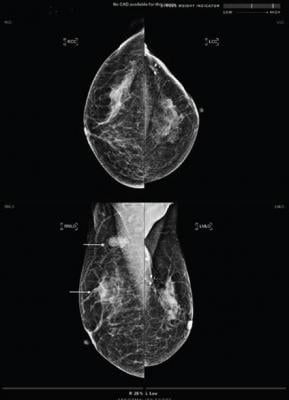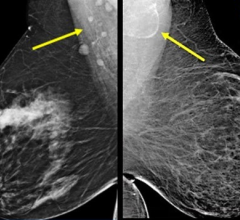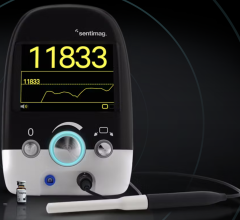
AI-CAD marked axillary lymph node and region in right upper outer quadrant (arrows and thin line outlining both sites) and assigned an abnormality score of 28%.
August 11, 2021 — According to an open-access Editor’s Choice article in the American Journal of Roentgenology (AJR), artificial intelligence-based computer-aided detection (AI-CAD) can be a practical addition for lowering false-positive findings when performing post-breast conserving therapy (BCT) surveillance mammography.
“After BCT, adjunct digital breast tomosynthesis (DBT) or AI-CAD reduced recall rates and improved accuracy in the ipsilateral and contralateral breasts compared with digital mammography (DM),” wrote lead investigator Jung Hyun Yoon. “In the ipsilateral breast, addition of AI-CAD resulted in lower recall rate and higher accuracy than addition of DBT.”
Yoon and colleagues’ single-center retrospective study included 314 women (mean age, 53.2 years; 4 with bilateral breast cancer) who underwent BCT followed by DBT (mean interval from surgery to DBT, 15.2 months). Three breast radiologists independently reviewed images in three sessions: DM, DM with DBT, and DM with AI-CAD. Recall rates and diagnostic performance were compared between these three sessions using readers’ mean results.
Among these 314 women, the mean ipsilateral breast recall rate among all three readers was lower (p<.001) for DM with AI-CAD (1.9%) than for DM with DBT (4.1%). In the ipsilateral breast, both mean accuracy (97.0% vs 94.8%, p=.02) and specificity (98.3% vs 96.1%, p=.003) were higher for DM with AI-CAD than for DM with DBT, respectively.
Acknowledging that data regarding other AI-CAD applications for the post-BCT breast are scarce, “our study shows that recall rates decrease significantly when DBT or AI-CAD are used as adjuncts to DM for surveillance of the ipsilateral and contralateral breasts in women with a personal history of breast cancer after BCT,” the authors of this AJR article concluded.
For more information: www.arrs.org


 May 16, 2024
May 16, 2024 








